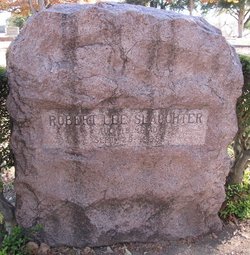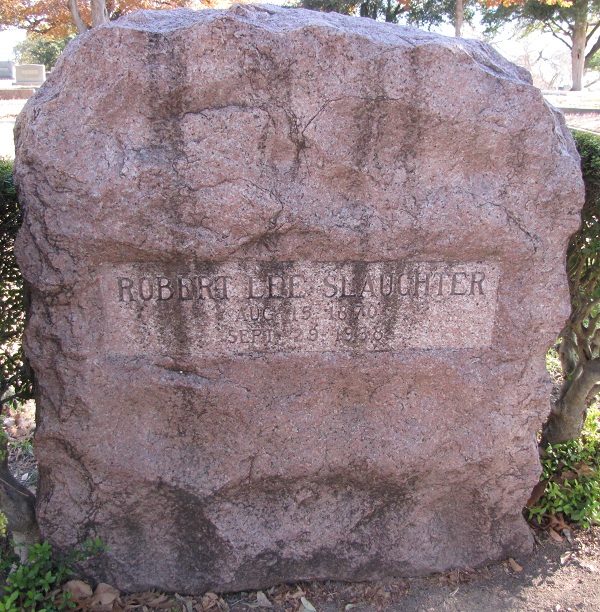In 1888, after Gus O'Keefe had resigned to start his own operation, Slaughter named eighteen-year-old Bob to succeed him as manager of the Long S, the ranch he had helped save. Though headstrong and boisterous, with a reputation as a practical joker, he was the most experienced cowman and thus the first of the Slaughter sons to assume a managerial role in the family business empire. As foreman he hired those he deemed "superior men," whom he paid five dollars a month more than the average wage. Although the panic of 1893 forced him momentarily to decrease those wages, while keeping his own salary at a mere seventy-five dollars a month, Slaughter enjoyed entertaining friends. By 1893 he settled into the routine life of a ranch manager after marrying Florence Harris. They had a son and later moved into a family residence at Midland. As the new century dawned Slaughter became heavily involved in the early land rushes and colonization efforts in Dawson and Howard counties. In 1909, when William P. Soash began buying up Long S properties, he put Slaughter in charge of his Soash Development Company, which founded Soash on the Howard-Borden county line. When automobiles came to West Texas, Slaughter bought a Pierce Arrow convertible, which he drove relentlessly over the ranch properties; fast cars soon became as much a passion to him as were fast horses and mules. Despite his good intentions, he never entirely settled into a standard routine. With his brother-in-law, George T. Veal, he invested in a large ranch southwest of Moctezuma, Sonora, Mexico, and also had ranching interests in the El Paso area. The resultant neglect of affairs on the Long S finally prompted C. C. Slaughter in 1911 to appoint Jack Alley to manage the ailing establishment. With the untimely death of his older brother George Morgan Slaughter in 1915, Bob Slaughter assumed management of the Lazy S, but his other interests continued to distract him, and after his father died in 1919, that ranch was divided among the Slaughter heirs to keep it solvent.
During the chaotic years of the Mexican Revolution, Slaughter's ranch in Sonora was raided and plundered of stock and provisions several times by Yaqui Indian rebels. One raid occurred while his son and daughter-in-law were staying there. By the time of his father's death, Slaughter had acquired the Western S Ranch on the Rio Grande in Hudspeth County. When his uncle, W. B. (Bill) Slaughterqv, who had been appointed manager of the Long S in 1916, attempted to sell that border operation behind his nephew's back, Bob and his younger brothers confronted and fired him, after which ensued a bitter but unsuccessful slander suit. In 1923 Slaughter sold his Midland residence and moved to Lubbock to be near his inherited portion of the Lazy S, the old Zavala Pasture in southwestern Hockley County. The following year, along with his brother Dick and sister, Minnie Slaughter Veal, he formed the Lone Star Land Company in partnership with Soash. Over the next two decades this firm sold tracts of both Long S and Lazy S properties and established the communities of Sundown and Vealmoor. On April 8, 1937, the first successful oil well in Cochran and Hockley counties was drilled by the Texaco company on Slaughter's portion of the Lazy S, five miles south of Sundown. Slaughter died at a Dallas hospital on September 29, 1938, and was interred in the family mausoleum at East Oakwood Cemetery in Fort Worth.
Bob, Jr., his sole offspring, grew up in affluent surroundings. As a young heir to millions, "Little Bob" often made headlines in local papers because of several sensational lawsuits in the Dallas courts, including one in 1921 in which a young lady sued him for $200,000 for an alleged breach of promise; however, that case was declared void by default since neither party nor attorneys appeared. Little Bob and his wife, Sue Alice (Teal), were prominent in high society and active in the Slaughter ranching interests, but they had no children of their own. During the Great Depression, when farmers were unable to continue their land payments, Little Bob reacquired a large portion of the inherited land his father had sold; after oil was discovered he reportedly wore out two Lincoln Continentals in his zealous efforts to get this land back into the family's possession. After his death in 1969 at the Ochsner Clinic in New Orleans, his widow resided in Grapevine. The saga of Bob Slaughter remains legendary in the history of large-scale ranching and big business in Texas. Perhaps J. Frank Dobie best summed up his philosophy toward life: "He was probably by a lot of things as he was by the freezing norther-moving too fast to let them enter into him."
BIBLIOGRAPHY:
Lillian Brasher, Hockley County (2 vols., Canyon, Texas: Staked Plains, 1976). Mary Whatley Clarke, The Slaughter Ranches and Their Makers (Austin: Jenkins, 1979). David B. Gracy II, "Selling the Future: A Biography of William Pulver Soash," Panhandle-Plains Historical Review 50 (1977). Tanner Laine, Cow Country (Hereford, Texas: Pioneer, 1969). David J. Murrah, C. C. Slaughter: Rancher, Banker, Baptist (Austin: University of Texas Press, 1981).
In 1888, after Gus O'Keefe had resigned to start his own operation, Slaughter named eighteen-year-old Bob to succeed him as manager of the Long S, the ranch he had helped save. Though headstrong and boisterous, with a reputation as a practical joker, he was the most experienced cowman and thus the first of the Slaughter sons to assume a managerial role in the family business empire. As foreman he hired those he deemed "superior men," whom he paid five dollars a month more than the average wage. Although the panic of 1893 forced him momentarily to decrease those wages, while keeping his own salary at a mere seventy-five dollars a month, Slaughter enjoyed entertaining friends. By 1893 he settled into the routine life of a ranch manager after marrying Florence Harris. They had a son and later moved into a family residence at Midland. As the new century dawned Slaughter became heavily involved in the early land rushes and colonization efforts in Dawson and Howard counties. In 1909, when William P. Soash began buying up Long S properties, he put Slaughter in charge of his Soash Development Company, which founded Soash on the Howard-Borden county line. When automobiles came to West Texas, Slaughter bought a Pierce Arrow convertible, which he drove relentlessly over the ranch properties; fast cars soon became as much a passion to him as were fast horses and mules. Despite his good intentions, he never entirely settled into a standard routine. With his brother-in-law, George T. Veal, he invested in a large ranch southwest of Moctezuma, Sonora, Mexico, and also had ranching interests in the El Paso area. The resultant neglect of affairs on the Long S finally prompted C. C. Slaughter in 1911 to appoint Jack Alley to manage the ailing establishment. With the untimely death of his older brother George Morgan Slaughter in 1915, Bob Slaughter assumed management of the Lazy S, but his other interests continued to distract him, and after his father died in 1919, that ranch was divided among the Slaughter heirs to keep it solvent.
During the chaotic years of the Mexican Revolution, Slaughter's ranch in Sonora was raided and plundered of stock and provisions several times by Yaqui Indian rebels. One raid occurred while his son and daughter-in-law were staying there. By the time of his father's death, Slaughter had acquired the Western S Ranch on the Rio Grande in Hudspeth County. When his uncle, W. B. (Bill) Slaughterqv, who had been appointed manager of the Long S in 1916, attempted to sell that border operation behind his nephew's back, Bob and his younger brothers confronted and fired him, after which ensued a bitter but unsuccessful slander suit. In 1923 Slaughter sold his Midland residence and moved to Lubbock to be near his inherited portion of the Lazy S, the old Zavala Pasture in southwestern Hockley County. The following year, along with his brother Dick and sister, Minnie Slaughter Veal, he formed the Lone Star Land Company in partnership with Soash. Over the next two decades this firm sold tracts of both Long S and Lazy S properties and established the communities of Sundown and Vealmoor. On April 8, 1937, the first successful oil well in Cochran and Hockley counties was drilled by the Texaco company on Slaughter's portion of the Lazy S, five miles south of Sundown. Slaughter died at a Dallas hospital on September 29, 1938, and was interred in the family mausoleum at East Oakwood Cemetery in Fort Worth.
Bob, Jr., his sole offspring, grew up in affluent surroundings. As a young heir to millions, "Little Bob" often made headlines in local papers because of several sensational lawsuits in the Dallas courts, including one in 1921 in which a young lady sued him for $200,000 for an alleged breach of promise; however, that case was declared void by default since neither party nor attorneys appeared. Little Bob and his wife, Sue Alice (Teal), were prominent in high society and active in the Slaughter ranching interests, but they had no children of their own. During the Great Depression, when farmers were unable to continue their land payments, Little Bob reacquired a large portion of the inherited land his father had sold; after oil was discovered he reportedly wore out two Lincoln Continentals in his zealous efforts to get this land back into the family's possession. After his death in 1969 at the Ochsner Clinic in New Orleans, his widow resided in Grapevine. The saga of Bob Slaughter remains legendary in the history of large-scale ranching and big business in Texas. Perhaps J. Frank Dobie best summed up his philosophy toward life: "He was probably by a lot of things as he was by the freezing norther-moving too fast to let them enter into him."
BIBLIOGRAPHY:
Lillian Brasher, Hockley County (2 vols., Canyon, Texas: Staked Plains, 1976). Mary Whatley Clarke, The Slaughter Ranches and Their Makers (Austin: Jenkins, 1979). David B. Gracy II, "Selling the Future: A Biography of William Pulver Soash," Panhandle-Plains Historical Review 50 (1977). Tanner Laine, Cow Country (Hereford, Texas: Pioneer, 1969). David J. Murrah, C. C. Slaughter: Rancher, Banker, Baptist (Austin: University of Texas Press, 1981).
Family Members
Sponsored by Ancestry
Advertisement
Records on Ancestry
Advertisement
















